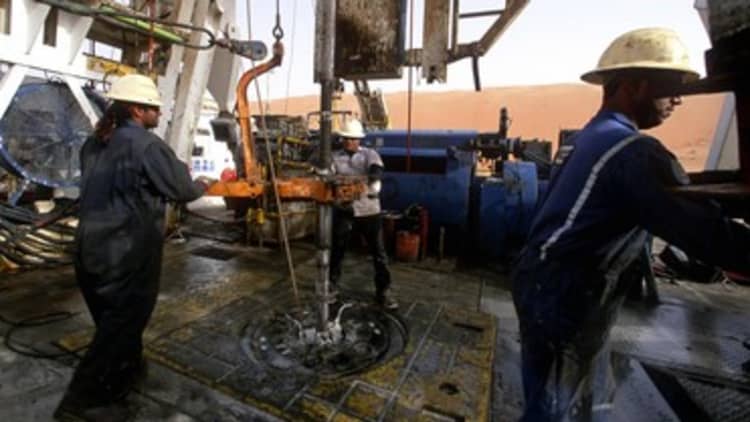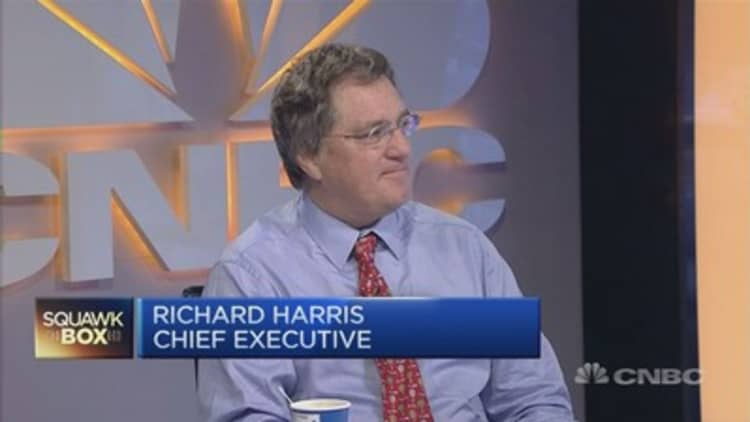
Amid a continued oil slump and record state budget deficit, analysts are contemplating whether Saudi Arabia could decide to abandon its currency peg against the dollar.
On Monday, Saudi Arabia announced plans to reduce its state budget deficit—caused by a dramatic drop in oil prices over the last 18 months that have hit its oil revenues—with spending cuts and plans to raise revenues from sources other than oil.
The government of the world's top oil exporter ran a deficit of 367 billion riyals ($97.9 billion) in 2015, the Council of Economic and Development Affairs said on Monday, Reuters reported. Its 2016 budget plan aims to cut that to 326 billion riyals.
Revenues next year are forecast at 514 billion riyals, down from revenues of 608 billion riyals in 2015.
Saudi Arabia's currency has been pegged to the dollar since 1986 and had afforded the country credibility and stability.
However, the dramatic fall in oil prices (in no small part brought about by Saudi's own decision, as the de facto leader of OPEC, not to cut in production to support prices) and a strengthening dollar have made the peg less attractive and Saudi is having to use its foreign exchange reserves to prop up both the budget and support the peg.
Oil is denominated in dollars and the government relies on the commodity for the bulk of its revenue.
While abandoning a peg and effectively devaluing a currency can help exports by making them more attractive versus competitors—which could help major oil exporter Saudi Arabia—such a move could be dangerous. Saudi is also a large importer of equipment, cereals and consumer goods and a weaker currency means these would be more expensive.
Abandoning a peg, or re-pegging at a lower value, can also damage investor confidence and prompt capital flight and volatility. A few weeks ago, Azerbaijan unpegged its manat from the dollar and the currency lost more than half its value against the greenback.
Kit Juckes, global head of foreign exchange strategy at Societe Generale, told CNBC that, with the peg being in place for 30 years, Saudi would be "very reluctant to adjust it."
"For a big commodity exporter and a big importer, the benefit of a devaluation is offset by a jump in import prices, so it's not popular, but it does help get the budget deficit down significantly by increasing domestic revenues (oil) without increasing spending so much (salaries)," Juckes told CNBC via email.
"So far, the decision to adopt fiscal austerity shows 1) that there is a huge fiscal shortfall and 2) they'd rather tighten their belts than think about devaluation. But if the oil price stays low enough for long enough and the fiscal situation doesn't improve as hoped, (who knows)," he added.
Countries looking at abandoning fixed exchange rates should proceed with caution and despite speculation over the future of the riyal, other analysts agree that Saudi Arabia is probably not at the point where it was ready to abandon its peg for the uncertainty of a floating exchange rate.
"The sharp adjustment lower in the price of crude oil has also encouraged speculation that Saudi Arabia may exit its peg against the U.S. dollar which has been in place since June 1986. However, there has been no indication this is officially under consideration," Lee Hardman, currency analyst at Bank of Tokyo-Mitsubishi UFJ, said in a note on Tuesday.
"The peg has remained in place during prior sharp adjustments lower in the price of crude oil and Saudi Arabia's FX reserves remain significant at over $600 billion. Speculators looking for a devaluation of the riyal are likely to remain disappointed in the year ahead. However, it is a tail risk which could result in a broader impact on foreign exchange market performance," he added.

Earlier in 2015, in August, Ahmad Al Kholifey, the Saudi central bank's deputy governor for research and international affairs, told Al Arabiya television that authorities would maintain the peg at 3.75 riyals per dollar.
Michael Cirami, portfolio manager at Eaton Vance Global Fixed Income, told CNBC that the country needed to act in some way to protect the economy.
"Something needs to happen (in Saudi Arabia) and it's not clear what is going to happen -- whether the budget's going to be corrected or if there needs to be something on the monetary policy side, and here I'm specifically talking about the currency peg," he told CNBC earlier in December.
To see the country abandoning the peg, Cirami said there would either need to be an unpredictable, "black swan" kind of geopolitical event within Saudi Arabia, or continued volatility in oil prices. Abandoning the peg was not imminent, he added.
"It's not something for now or possibly 2016 but when you look out a bit further the pressures are going to be there," he said.




